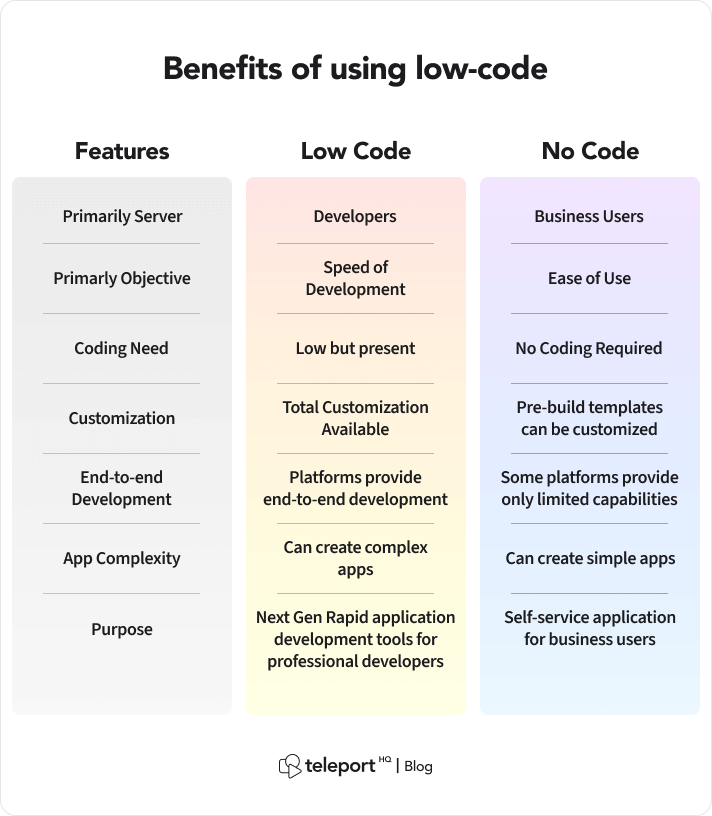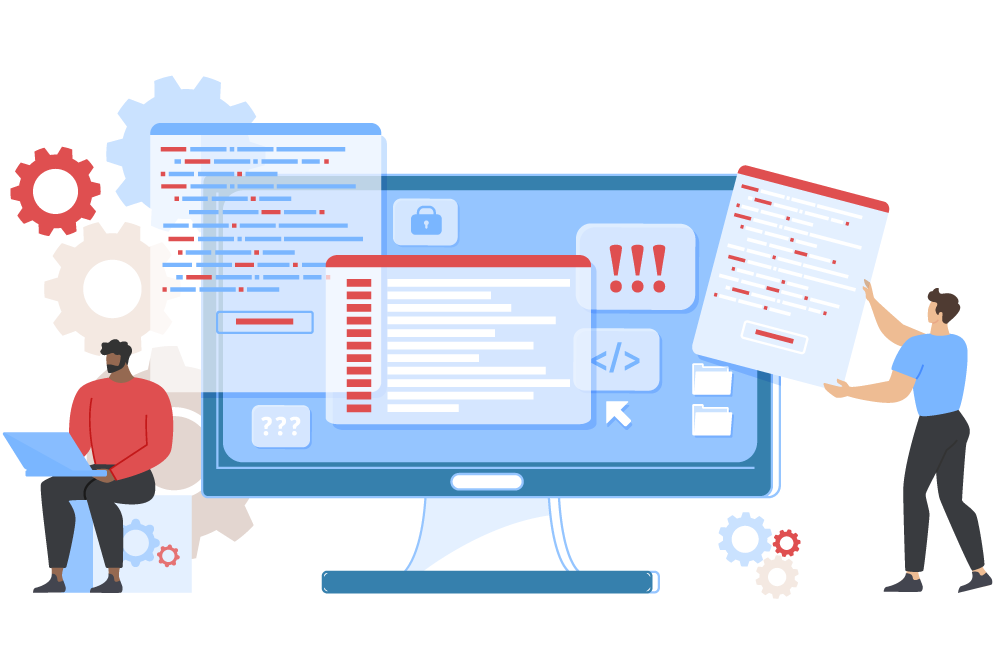Recommended Reasons On Picking Low-Code Platform Info
Wiki Article
The Advantages Of Low-Code Development For Developing Applications As It Relates To Integration Capabilities
Low-code development is an excellent way to build applications that seamlessly integrate with various systems and services. Here are key benefits from connectors that are pre-built, APIs, as well as other tools:
An extensive range of connectors. Low-code systems usually include many built-in connections to enterprise systems that are popular (e.g. cloud-based services, databases and CRM). The integration process is simplified.
API Integration: Many low-code platforms include out-of the-box integration API capabilities that allow developers to easily connect with external services and sources of data.
User-Friendliness
Drag-and-Drop Integration integration tasks can usually be accomplished using drag-and-drop interfaces, making it possible to both developers and non-developers to design complex integrations without writing extensive code.
Visual Workflow Builders : Software to create workflows and data flows that are visualized help learn and configure integrations in a more intuitive way.
Standardized Integration Methods:
SOAP and RESTful Services Support for web services protocols like REST and SOAP allows for straightforward integration with a wide range of other software and systems.
OData and other Standards Support for other standards such as OData enables easy access and manipulation of data across a variety of platforms and applications.
Real-Time Data Synchronization:
Real-Time Integrations: Low-code platforms are capable of handling the real-time synchronization of data among systems, applications as well as databases. This ensures that the data is always up-to date and consistent across an organisation.
Event-Driven architecture: Certain platforms can support event-driven architectures. This lets applications react to events in real-time, which is essential for interactive and dynamic apps.
Legacy System Integration:
Low-code platforms are commonly used to integrate legacy systems. This lets organizations upgrade IT infrastructures without having to completely overhaul the existing systems.
Data Migration Tools Built-in data-migration tools make it easy to transfer data from older systems to applications that use low-code.
Third-Party Service Integration:
Cloud Services: Seamless Integration with Cloud Services such as AWS Azure Google Cloud and Google Cloud enables easy deployment of applications.
Business Application Integration: Low-code platforms can integrate with various business software like Salesforce, SAP, Microsoft Dynamics and more. to create a seamless workflow across different business tasks.
Simple Data Management
Unified Data models: Certain low-code platforms provide unified data models that simplifies data integration and management across different systems.
Data connectors: Data connectors that are preconfigured to allow easy access and modification to data from a variety of sources.
Security and Compliance
Low-code platforms help ensure integrations comply with security protocols and standards and safeguarding data while it is in transit as well as in its rest.
Security Features: These platforms typically have features that make sure that integrations comply with regulatory requirements, such as GDPR or HIPAA. This provides peace ofmind for businesses handling sensitive information.
Extensibility:
Custom Codes and scripts. To meet more intricate requirements in integration, low-code platforms often allows the inclusion custom code and scripts. This provides flexibility without compromising user convenience.
Plug-in Ecosystem A collection of plugins and extensions that can extend integration capabilities by allowing users to implement new functions as they are needed.
Low-code platforms can be a useful device to build interconnected, effective and scalable applications. They make it easier for connecting disparate systems, enhance data flow, and enable businesses to leverage existing technologies while adopting new ones, which results in the integration of a seamless IT environment. Read the top rated click this link about Low-code Platform for application development for blog info including database in azure, driver jdbc, no code platforms, develop web application, microsoft azure sql, cross platform mobile dev, app development platform, rapid app development, mobile app development platforms, cross platform app dev and more.

Advantages Of Low-Code Application Development In Terms Of Flexibility And Scalability
Low-code development can bring many benefits in regards to scalability and flexibility that are essential for developing applications that can be able to grow and adapt to the changing needs of business. Here are the major benefits:
Cloud-based deployment. A lot of low-code platforms offer a cloud-based deployment, which allows them to scale applications seamlessly with cloud infrastructure. This lets businesses handle increased loads without worrying about server management.
Auto-Scaling: The auto-scaling feature will automatically adjust the resources according to demand. This guarantees the same performance even during peak hours and without manual intervention.
Flexible Architecture:
Modular design Low-code platforms are great way to promote modular applications. These allow components to be developed independently as well as tested, sized, etc. Modularity provides greater flexibility and allows to modify or expand specific areas of the application, without affecting other components.
Microservices Architecture: Microservices architecture enables the development of applications using a loosely coupled collection of services. This allows for greater capacity and flexibility.
Customizable Solution:
Flexibility : Low-code platforms allow developers to extend functions beyond what they are able to provide. This guarantees that specific requirements of business can be met without constraints.
Third-Party Integrations: The capability of businesses to connect third-party applications and APIs and add new functions to the application as needed, increases its capabilities.
Agile Development, Deployment and Agile Development:
Continuous Delivery and Deployment Low-code platforms can support agile methodologies which allow continuous integration, continuous delivery (CI/CD). This facilitates rapid release of updates and features. The applications can grow rapidly in response to market changes and feedback from users.
Iterative Devlopment: Due to the nature of iterative development, low-code applications can scale and evolve gradually. This helps reduce the risks associated with major changes and allows for greater control over expansion.
Resource Optimization
Low-code platforms offer tools to analyze and monitor the performance of applications, which helps to optimize the use of resources. This makes sure that resources are used efficiently and are easily scaled to meet actual needs.
Load Balance: This feature lets the application manage massive traffic by distributing workloads among multiple servers. It also ensures that the performance remains consistent.
Global Reach
Multi-Region availability: Lowcode platforms permit to be used across a variety of regions. Businesses can offer users high-speed, low-latency global access. This is essential for applications that cater to a global audience.
Localization Support built-in support for localization enables applications to easily adapt to various languages and regional needs and thereby allowing them to be more flexible in various markets.
Maintenance and updates
Low-code software is visually appealing and modularly designed, which simplifies maintenance. Updates and bug fixes can be done quickly and without a lot of downtime.
Version Control: Integrated versions control systems permit the safe deployment of updates and rollbacks. Previous versions can also be restored in the event that they are needed.
Cost Efficiency:
Low development costs. Through reducing the code requirements, low-code platforms cut down on the cost of development and permit applications to be scaled up without requiring more development efforts.
Pay-as-you-go models: Many platforms for low-code offer flexible pricing options, like pay-as-you go model that aligns prices and usage with actual growth.
The scalability of low-code applications lets businesses develop strong and flexible, scalable and durable applications. These platforms allow for rapid adjustments to meet changing requirements as well as efficient utilization of resources and continuous improvement, ensuring that the application can expand and change to meet the needs of the business. Take a look at the top rated Enterprise application development with Low-code Platform advice for more tips including developing mobile apps, ms azure sql, azure sql server, jdbc server, azure sql databases, microsoft azure sql, rad application development, cross platform mobile app development, paas service, azure sql server and more.

Support From Vendors And Community Are Two Benefits Of Low Code Application Development.
Low-code platform development offers significant advantages, such as support from vendors and a community. This is crucial for ensuring the success of application implementation as well as ongoing maintenance and constant improvement. Support from the Vendor
Comprehensive Technical Support:
Support Teams: Several Low-Code platforms offer a to a dedicated support team that can assist in technical issues, guidance and troubleshooting.
24/7 Support Available: Certain companies provide 24/7 support that is especially beneficial for businesses that operate globally and in different time zones.
Training and Onboarding
The structured training programs offered by vendors offer structured courses like webinars or certification courses. This helps users quickly get to grips with the platform.
Personalized Onboarding: Many vendors offer personalized onboarding to assist new customers implement the platform effectively and tailor it to their particular requirements.
Regular Updates and enhancements:
Continuous Improvement: Low-code platform providers provide regular updates that include new features, security patches, and enhancements to performance. This ensures that the platform remains updated and safe.
Feedback Integration Vendors incorporate user feedback into the development process, making sure that the platform is updated in response to the changing requirements.
Comprehensive Documentation:
Documentation - Detailed detailed and well organized documentation that covers everything from basic usage to advanced customisations and is usually available. This allows users to solve problems independently.
API References API documentation can help developers to customize and integrate their applications with the Low-Code platform.
Consulting and Professional Services
Expert Consulting: Vendors often offer consulting services to assist with strategic planning, architecture design, and complicated implementations, to ensure that users are able to use the platform to its maximum potential.
Custom Development Services: Certain providers offer custom development services to build specific features or integrations that aren't available in the standard package.
Community Support for the Community
Active User Community:
Discussion boards and forums A number of low-code platforms have vibrant online communities for users to share ideas, ask questions and collaborate.
User Groups and Meetings: Both local and virtual groups of users and meetups offer opportunities to learn to network, share information, and exchange experiences with others.
Collaboration and Knowledge Sharing
Community-Contributed Resources: Users often share templates, modules, and extensions that they have developed, which can be reused or adapted by others, accelerating development and innovation.
Crowdsourced Problem Solving: The collective expertise and experiences of the community can be a valuable resource for troubleshooting issues and finding creative solutions to complicated issues.
Learning and Development
Community-led training: Many community groups offer training sessions, webinars, and workshops led by experts who are experts in their area.
Online Tutorials & Courses: The community members frequently publish online tutorials, classes and tutorials for how to perform tasks, which enhances learning resources.
Feedback and Influence
Product Feedback: Many forums have channels for giving feedback to manufacturers. This feedback can affect the development of new features and enhancements.
Beta Testing Programmes: Community members who are active get the chance to take part in beta testing programs. This allows them to get an early glimpse of new features and also a a chance to help shape the platform’s evolution.
Recognition and Encouragement
Community Recognition Programs: Many vendors offer recognition programs to honor the efforts of community members who are active like MVP (Most Valuable Professional) programs.
Peer Support. Community members offer peer-to-peer support. They share their knowledge with users who are less familiar and offer advice. This creates an environment of collaboration and support.
Overall, the combination is robust vendor and active and engaged communities. They provide an extensive environment to support of low-code applications development. The combination of robust vendor support and a vibrant, engaged community provides an entire support network for low-code development.
